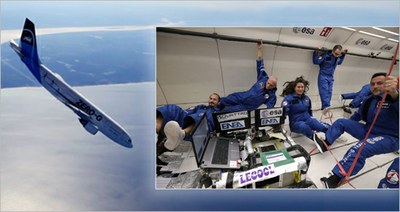Space: ENEA tests an innovative highly efficient cooling system for spacecraft
16/1/2020
 A team of ENEA researchers tested an innovative highly efficient cooling system in microgravity conditions. The system was designed to ensure the functioning of sophisticated electronic instruments on board spacecraft.
A team of ENEA researchers tested an innovative highly efficient cooling system in microgravity conditions. The system was designed to ensure the functioning of sophisticated electronic instruments on board spacecraft.
The trials − which took place in France during the 72nd ESA parabolic-flight campaign − were conducted on advanced two-phase cooling” heat control systems, which manage to optimally dissipate the heat produced by electronic equipment.
This technology represents a significant step forward compared to the systems adopted so far, based on air or liquid cooling, with marked limitations in terms of maximum 'removable' thermal power,” says ENEA researcher Giuseppe Zummo of the laboratorio di “Sviluppo Processi Chimici e Termofluidodinamici per l’Energia” (chemical and thermo-fluid dynamic processes developcment for energy laboratory), who tested the system together with laboratory colleagues Luca Saraceno and Antonio Scotini.
In order to study the behaviour of refrigerant fluids in closed circuits with zero gravity the ENEA researchers used sophisticated experimental equipment, such as the MICROBO (MICROgravity BOiling) system, equipped with hi-tech automation and safety systems, miniaturized sensors, tube coating treatments to heat the fluid, and high-speed cameras.
These activities were conducted together with the startup ‘In Quattro’, an ENEA spin-off set up to market this new ‘two-phase cooling’ thermal control technology targeting other markets than aerospace. “ENEA research can be considered among the most advanced such efforts worldwide in the field of heat transmission in zero gravity conditions, thanks to the experience gained during our parabolic flights and analysis of the data collected in microgravity conditions”, adds Luca Saraceno.
“Boiling and condensation, i.e. transformations of a liquid into vapour and vice versa, represent the most efficient heat transmission mechanisms that can exist in nature, but these mechanisms are markedly complex and to date there is still no full understanding of these physical phenomena, especially in zero gravity conditions”, observes Antonio Scotini.
For ENEA, this is the tenth parabolic flight experimental campaign conducted together with ESA. The tests take place on board an Airbus ZERO-G aircraft of the NOVESPACE company from Bordeaux, which performs ninety 'parabolas' in the skies of France in three days.
Thanks to the particular manoeuvres performed by the four pilots, during each parabola it is possible to obtain, for about 20 seconds, conditions of zero- or, more precisely, micro-gravity. During these 20 seconds, researchers from all over Europe carry out their tests on the experimental systems mounted on board the plane, while floating in the air like astronauts.
ENEA’s “space” technologies were presented in Rome at the “New Space Economy - NSE ExpoForum”, the first edition of the international event for enhancement of the space production chain, whose turnover by 2040 is estimated at 1,500 billion euros. In addition to the MICROBO system, ENEA also brought its hi-tech kitchen garden – designed to grow microgreens in spacecraft and ensure that astronauts consume fresh produce, and are correctly fed with a high-quality diet − and an innovative device that enables the study of growth of plants under conditions of “simulated microgravity”, not to mention the very latest materials technology for the production of coatings resistant to the extreme conditions typical of space.
Lastly, a round table was held on “New Space Economy and Research”, with the representatives of the major Italian research institutions as well as institutions engaged in the sector. Representing ENEA, the director of ENEA’s department of “Tecnologie energetiche” (energy technologies), Gian Piero Celata, was in attendance.
For further information on MICROBO: https://www.kep.enea.it/impianti/impianto-sperimentale-microbo-microgravity-boiling.html
